Danish Smørrebrød
Danish Smørrebrød is an open-face sandwich, similar to several that we’ve covered previously, as well as Swedish Smörgås, which doesn’t appear on our List. In fact, we covered a type of Danish Smørrebrød way back in January of 2016 called Dyrlægens Natmad and we’re covering another next month called Sol over Gudhjem. While there are a few like this, classic combinations that generation after generation of Danes have enjoyed, for the most part, Smørrebrød are ad hoc creations, consisting of buttered Rugbrød with seafood, meat, or cheese and a variety of garnishes.
What combinations work, though? What are the rules of Smørrebrød? To find out, I joined a Facebook group called Dansk Mad og Opskrifter (Danish Food and Recipes) and asked. I also reached out to my friend Klavs, a Dane who has lived in the US for over 20 years, and asked him for some ideas. I did learn a few favorite combinations (and that Dyrlægens Natmad is still a popular favorite, more than a century after its inception), but more importantly, I learned that there is an etiquette to Smørrebrød, a method, an order of operations. Smørrebrød has a run book.
You always begin with the fish, herring, shrimp etc. Then you remove the fish plate and cutlery and use a fresh set of cutlery and a new plate, so that the fish doesn’t spoil the rest of the meal. You would then continue with the warm meat dishes, if available, before you end up with the cold meats with toppings, and round off with a few cheeses.
From Dansk Mad og Opskrifter
There is indeed a specific order involved, and knife and fork is generally used (if you buy smorrebrod at a restaurant, there will be so much stacked on top of the bread that knife and fork is the only clean way to get the food from plate to mouth). The fish is eaten first, and the pickled herring is traditionally first of the fish (if there are more than one type of fish). There is almost always herring of some sort(s), but not always other kinds of fish. There can also be several plates involved, even at home, so the fish (herring) is eaten from a smaller plate placed on top of a second plate, which is used for the meats and cheese. This is done to avoid the strongly flavored herring marinade from polluting the rest of the meal.
–Klavs Dolmer
So I took several of Klavs’ recipe suggestions, as well as others I found online, and constructed a meal of Smørrebrød for myself, Mindy, and Ian. I made seven sandwiches, covering the herring, hot and cold non-herring seafood, hot meat, cold cuts, and cheese types of Smørrebrød. It seemed to pass muster on Dansk Mad og Opskrifter, so I feel I may have at least come close to getting it right.
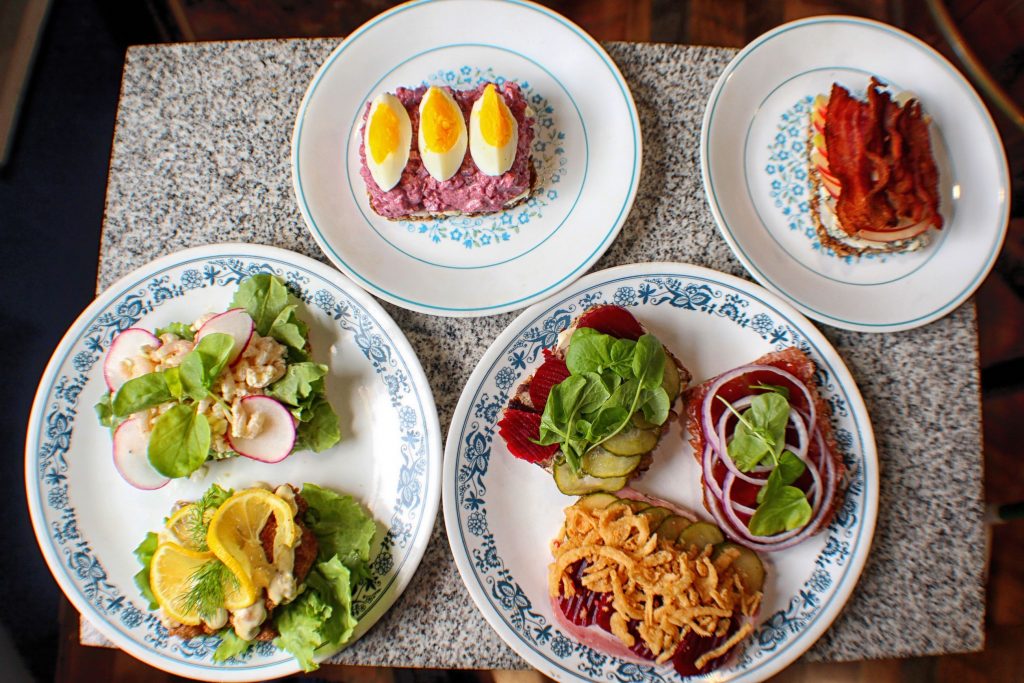
First though, I feel I should familiarize you with several of the ingredients we’ll be using.
Rugbrød
Rugbrød isn’t easy to find in the US. A few years ago I was able to buy a loaf from Pleasant House Bakery in Chicago, but unfortunately I learned when visiting the remaining Pleasant House business, a pub on Halsted, that they no longer bake bread in-house at all.
However, Rugbrød is still available from a few Danish bakeries in nearby Racine, Wisconsin. I drove to O&H Bakery on a Saturday to find some.

O&H wears their Danish-ness on their sleeve, from the Danish flag flying outside to the typical Danish baked goods such as Kringle that they serve. However, the small deli inside does not serve Smørrebrød. Instead, I bought a loaf or two of Rugbrød to bring home with me.
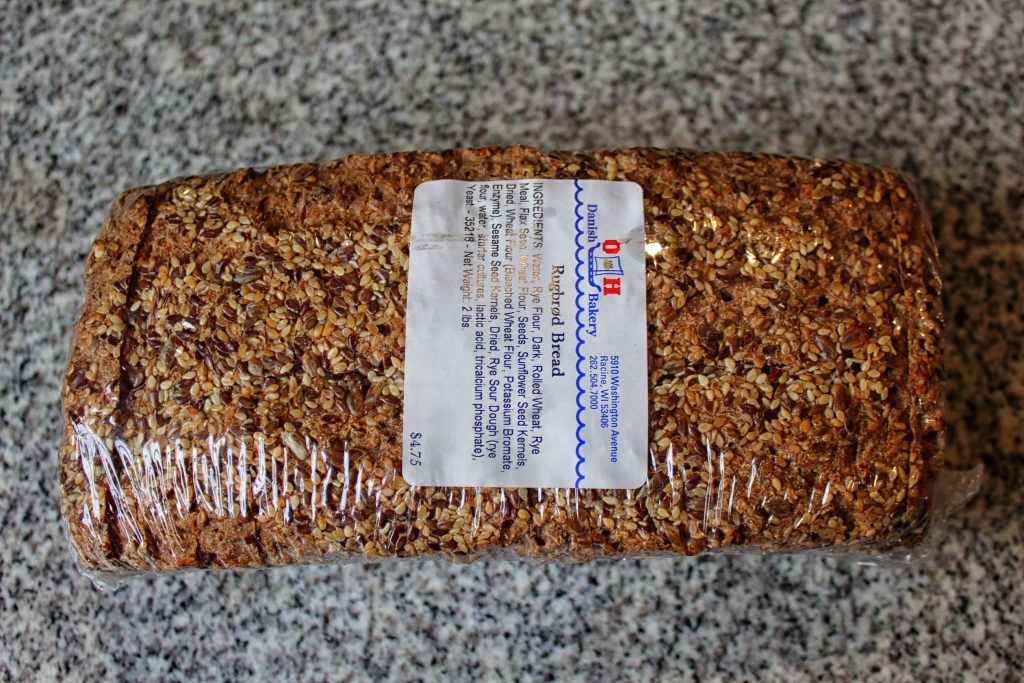
Rugbrød is a seeded sourdough rye, but instead of caraway seeds, it contains flax seeds, sunflower seeds, cracked rye kernels, and sesame seeds, making it a dense and highly-textured bread, best sliced thinly.
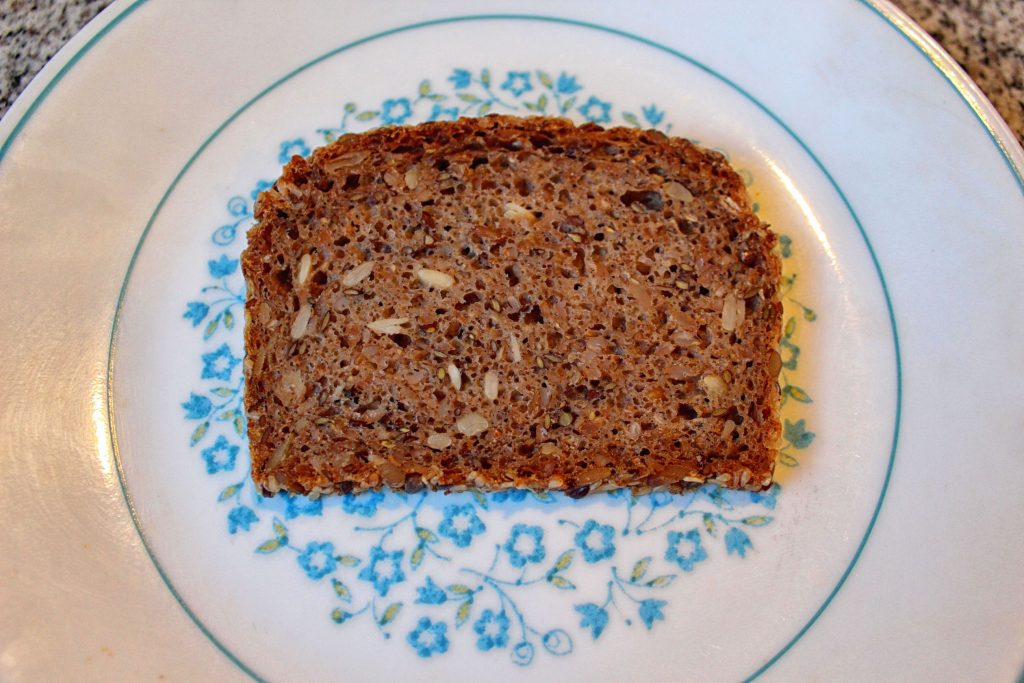
According to a Danish commenter on my Facebook thread, the butter is as important as the bread:
…butter has to cover the bread to the edges thick enough to keep the toppings from making the bread soggy – tandsmør, i.e., thick enough to leave tooth marks. Nowadays we think that’s overkill but, if you’re using Lurpak or at least European butter, it does taste good.
From Dansk Mad og Opskrifter
While I did not get actual Danish butter, I did get something close.
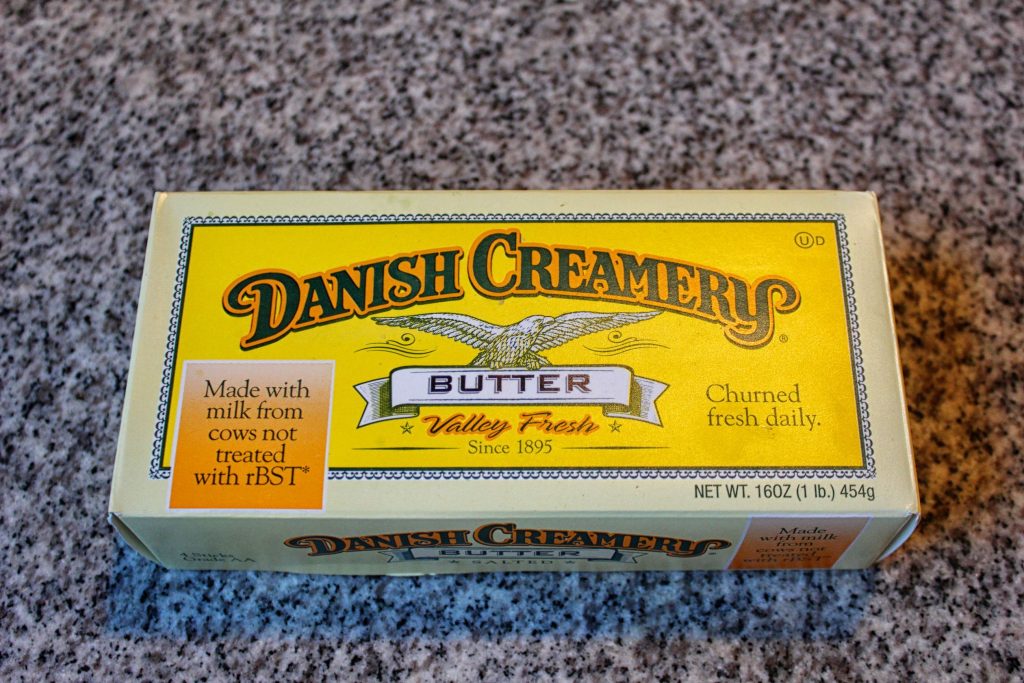
Other Ingredients
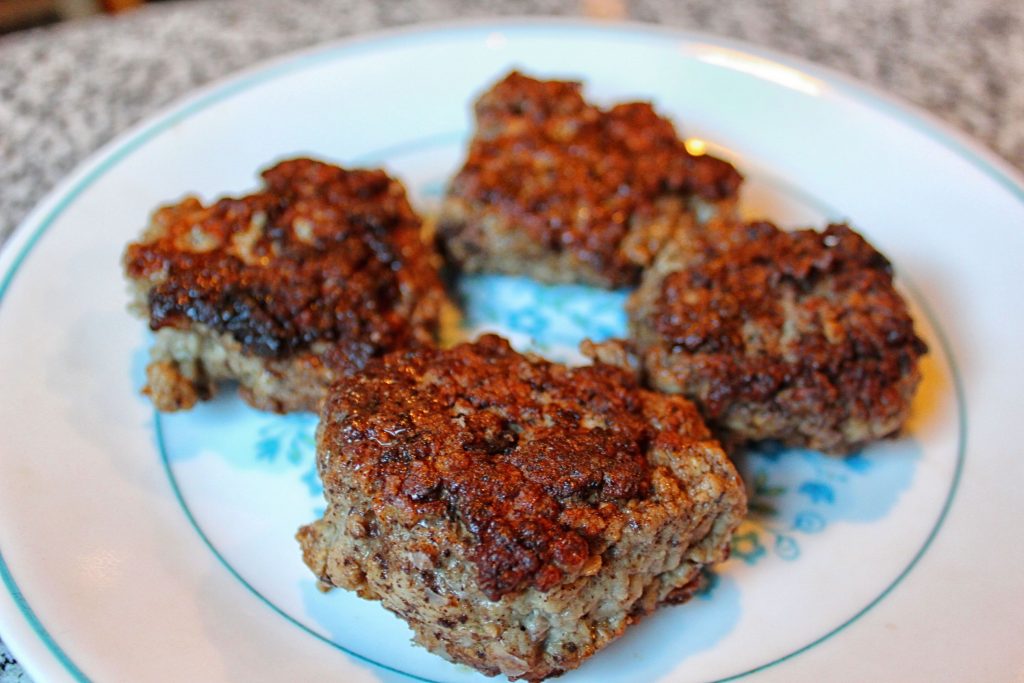
Frikadeller: Frikadeller are Danish meatballs, made with a combination of beef or veal and pork with grated onion, egg, milk, flour and/or breadcrumbs, and sometimes a pinch of allspice or clove. They are formed into round-but-flattish patties and pan-fried in butter until crisp on the outside and soft but cooked on the inside, and usually served as the centerpiece of a meal with red cabbage and mashed potatoes. Leftovers, however, often find their way into Smørrebrød.
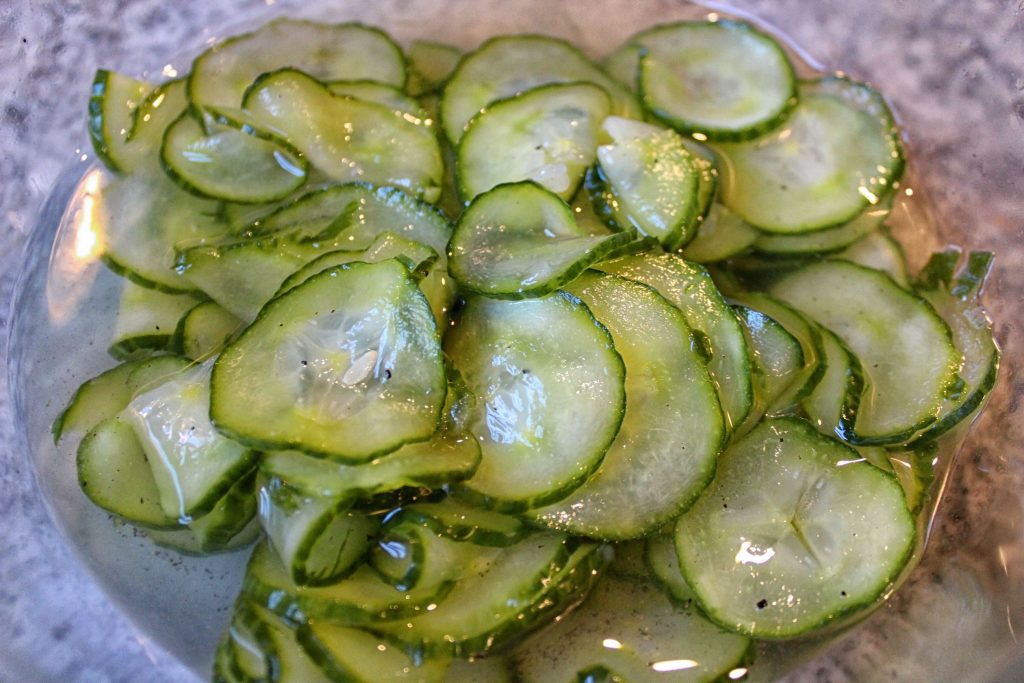
Agurk Salat: This is a Danish-style cucumber salad, consisting of thinly-sliced cucumber that is first lightly salted to draw out some moisture, then rinsed and drained and dressed with water, vinegar, and sugar. It is a common garnish for Smørrebrød.
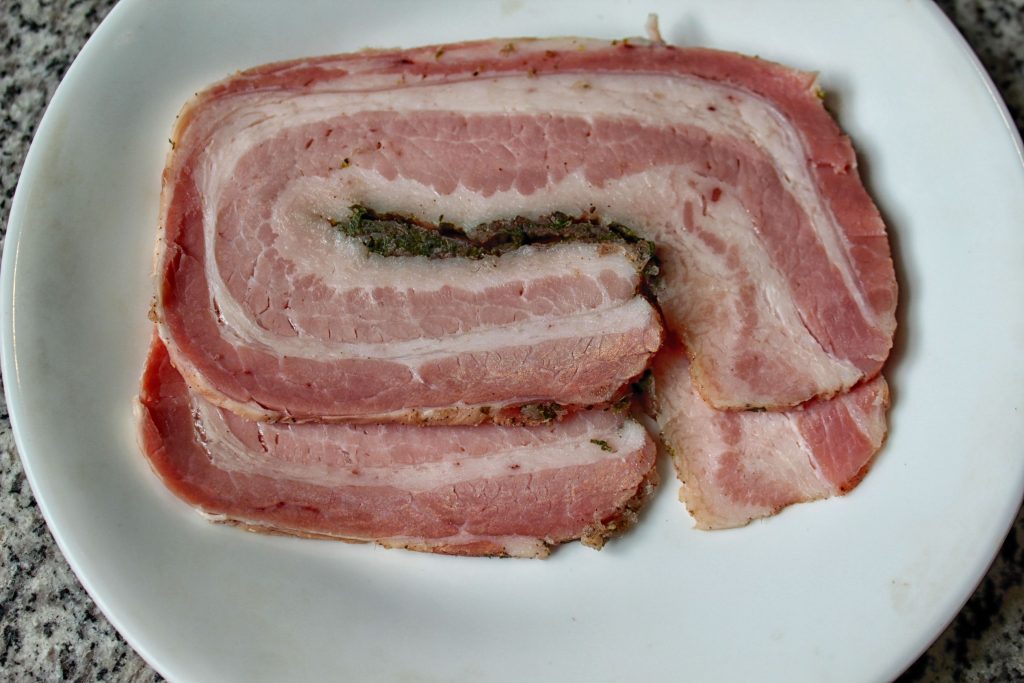
Rullepølse: Rullepølse is a type of Danish cold cut consisting of lightly-cured pork belly, smeared with a combination of grated onions, parsley, and allspice, rolled up tightly and tied with twine, then softly simmered for a couple of hours with aromatics such as onion, bay leaf, black peppercorns, allspice berries, juniper berries, carrots, etc. After it is cooked, it is pressed overnight into a rectangular shape before being untied and sliced thinly for sandwiches.
Smørrebrød
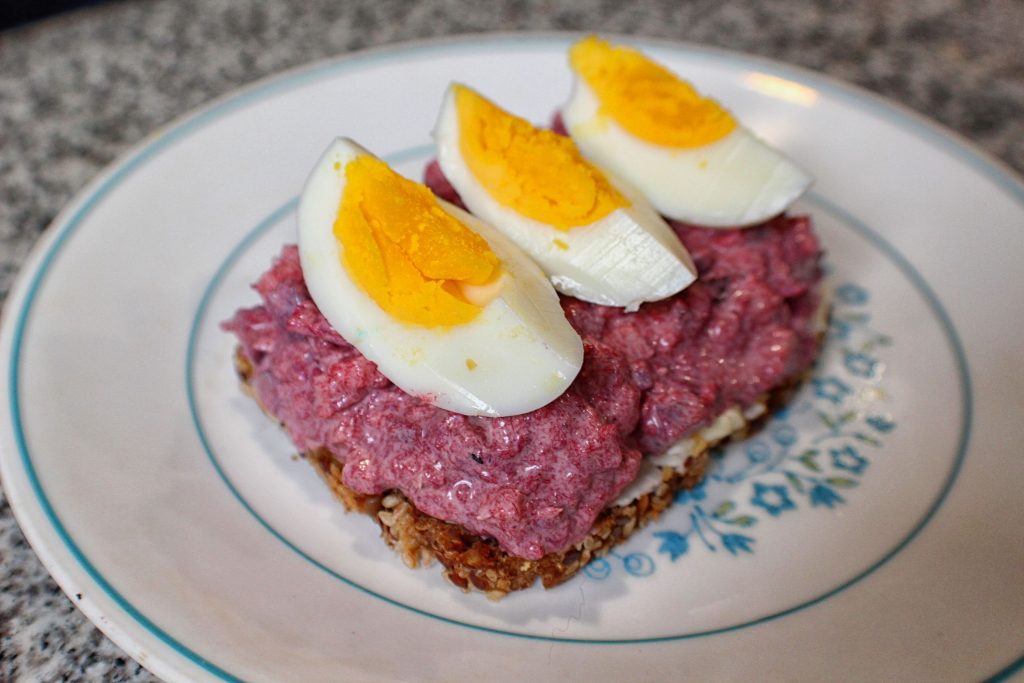
As specified, we start with herring. This is a pickled herring salad, a recipe I found on a site called Sid’s Sea Palm Cooking, a great resource for Danish cooking. It’s served with wedges of hard boiled egg atop buttered Rugbrød. The salad includes apples and beets as well as pickled herring and some roasted pork, and the dressing adds some beet brine as well to give it such a brilliant color. The flavor is briny and sweet, but earthy, and it was better-received than I’d hoped. Even Ian enjoyed a few bites.
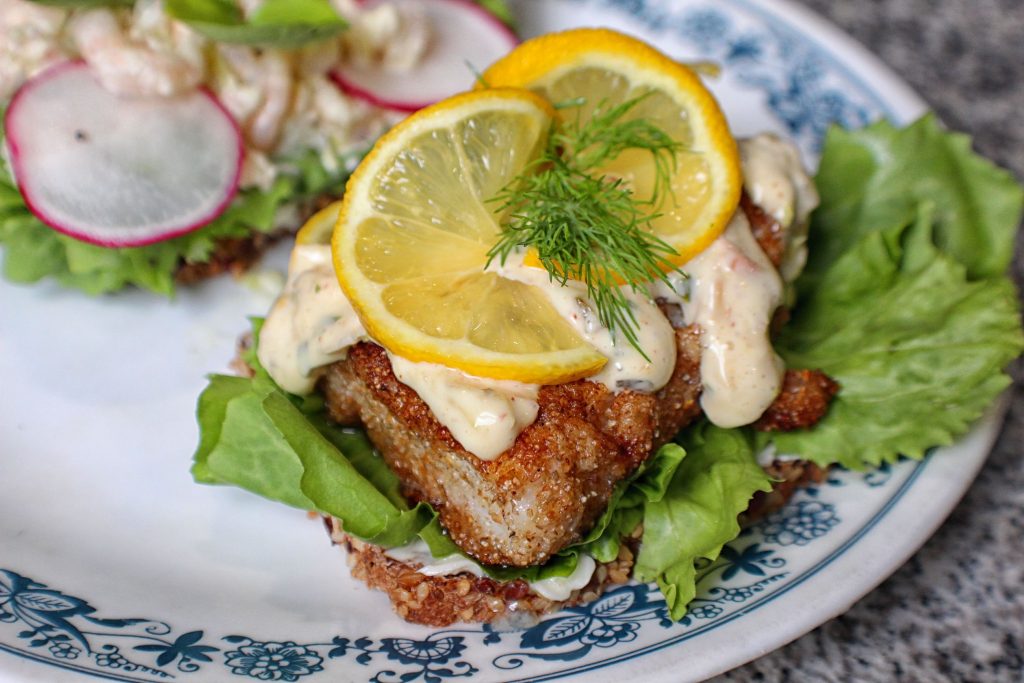
For a hot non-herring seafood Smørrebrød, I chose fried fish. Plaice appears to be the fish of choice among Danes, but doesn’t appear to be very common around here. Instead I used cod as a substitute, dredged in a mixture of rye flour and sea salt and fried in butter. I served it on a leaf of butter lettuce, with Danish remoulade, sliced lemon for squeezing, and a dill garnish. Not a bite of this went uneaten. Mindy and I have had several conversations recently about how we don’t eat enough fish, and this sandwich was proof that fish, well-prepared, could be an appreciated part of our diet.
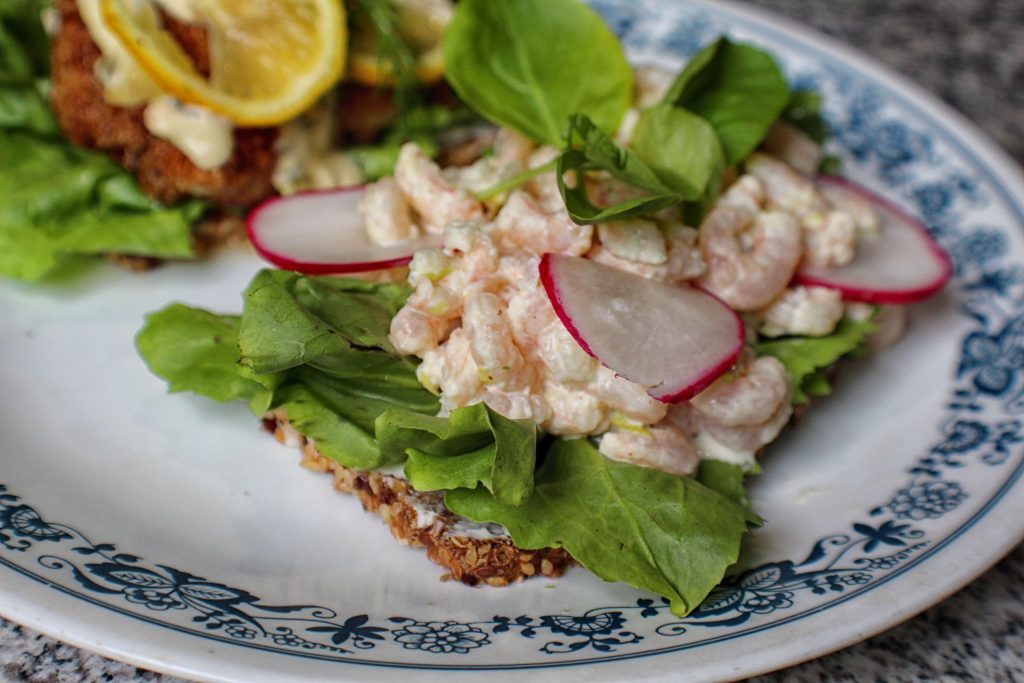
Next is a salad of tiny shrimp dressed with remoulade, served atop a leaf of butter lettuce, garnished with sliced radishes and cress. Again, this was a popular combination, and went quickly. The Danish remoulade sauce is slightly sweet from a touch of sugar, but lent an impression of greater sweetness from the anise-like flavor of minced tarragon. This sweetness was countered by the peppery spice of both the radish and cress and the slight bitterness of the lettuce. Overall it was a well-balanced combination of flavors.
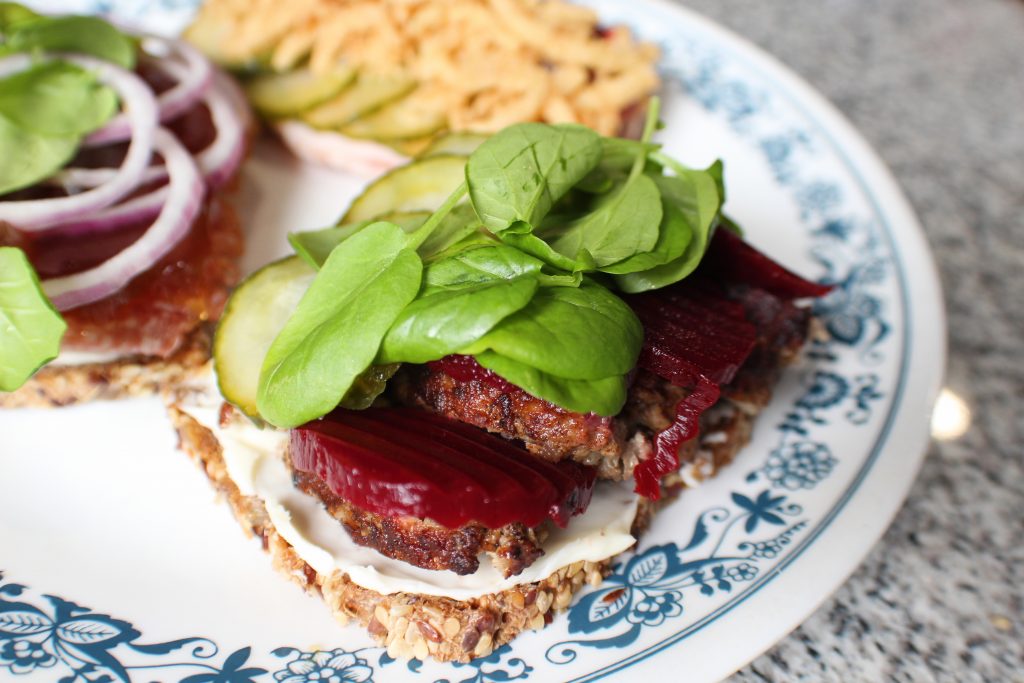
These meatballs were reheated in a pan, sliced, and served with beets, cucumber salad, and cress. The meatballs are mildly savory and the sweet/sour flavors of both the pickled beets and the cucumber salad are as effective a complement to it as the red cabbage is in a typical Danish meal. I’ll be honest though, I’ve been eating them over egg noodles with a sawmill gravy. Tastes like grandma’s house.
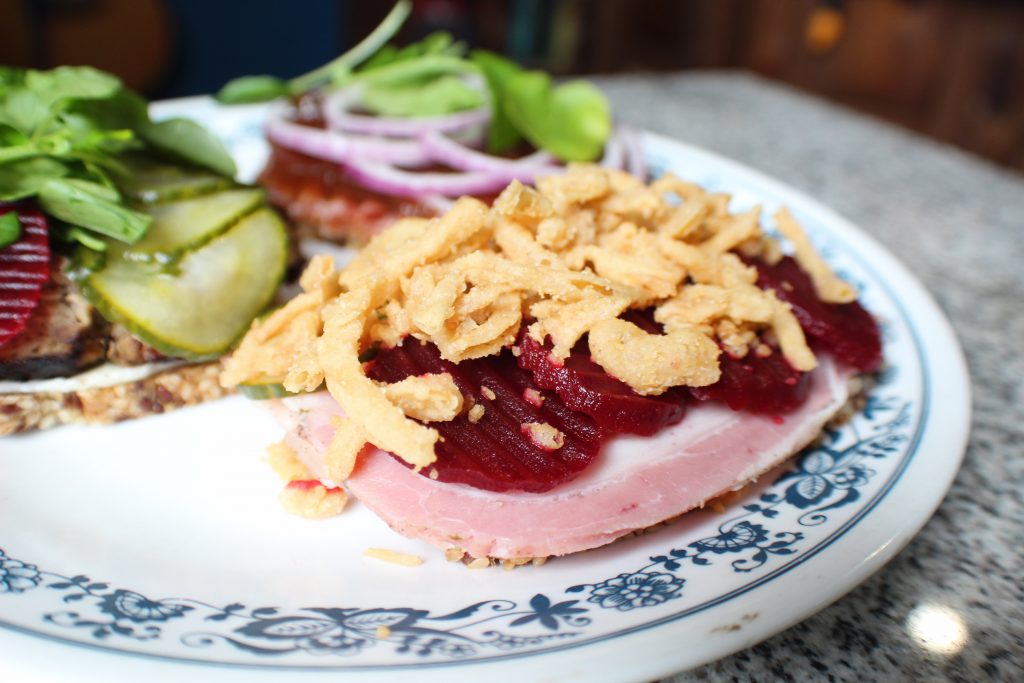
Klavs suggested roasted pork loin with cucumber, beets, or red cabbage along with crispy fried onions as a combination, and this is how I decided to use the Rullepølse. These are the same type of fried onions that one commonly sees on top of a green bean casserole or a similar dish on a holiday table. I can’t tell you what a revelation it is to have learned the use of these for a sandwich topping. My sandwiches will be more interesting going forward, now that I’ve learned this trick.
As for the Rullepølse, it was a lot of work, and it’s very good, but also fatty and rich. Intended to be served as a cold cut, rather than fried crisp like bacon, it’s got the soft texture of a braised pork belly, but with the pink color of a cured meat and a mild onion and parsley flavor and aroma. It was not a big hit with the family, though I’m a fan. I now have 2-3 pounds of it and I’m not sure how to use it up. I’m open to suggestions.
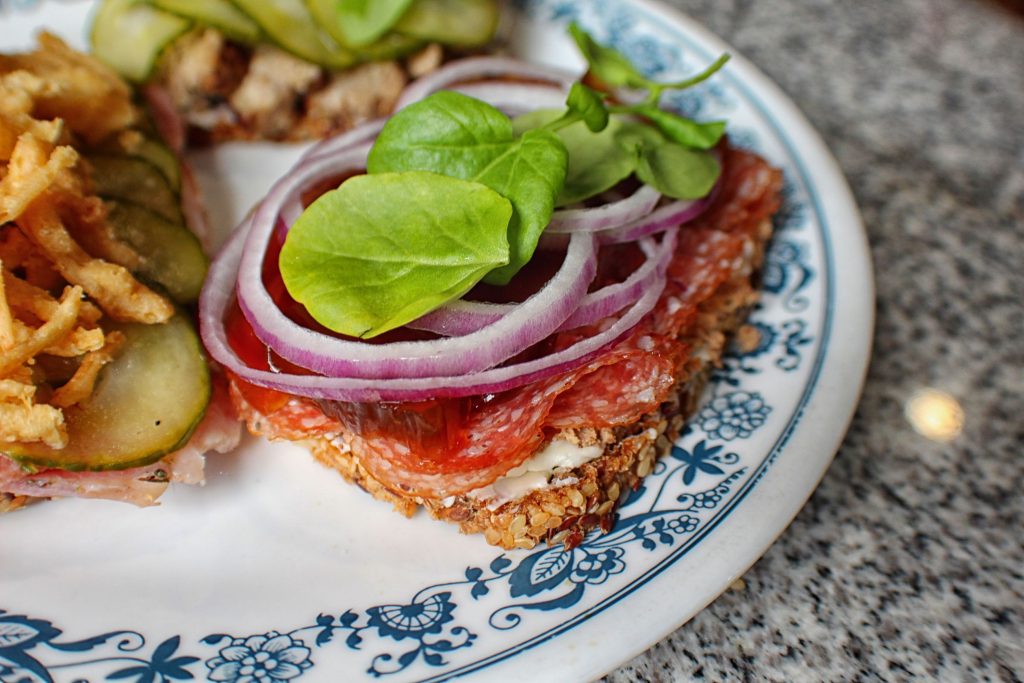
Salami with aspic, sliced raw onion and cress was another of Klavs’ suggestions. The addition of pork pate made it similar to a Dyrlægens Natmad variant. I knew this to be a good combination and I’m glad I served it again. The salami was a German-style Black Forest salami, smoky, salty, and lean, sliced very thin. Ian didn’t care for the raw onion but he’ll eat this salami all day.
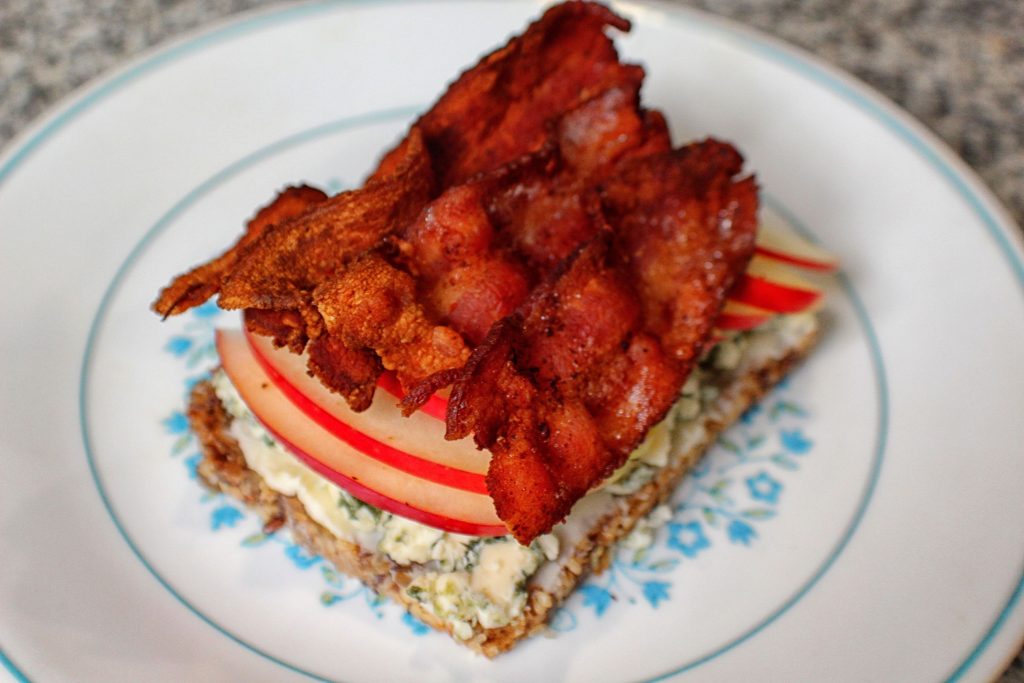
Finally, we made our way to the cheese course and… Well, blue cheese is a tough sell for many people, and this was a particularly strong Danish blue. Cheese, even at its best, is milk in a state of controlled rot, and the veins of mold in a blue cheese make that more plain than it is with the majority of cheeses. I thought the soft, salty cheese was a good match for the crisp thin slices of sweet/tart Braeburn apple and the salty/smoky and crisp bacon, but it wasn’t for everyone.
Danish food is both foreign and familiar to me, comfort food without the boost of nostalgia. I’ve eaten a lot of these Smørrebrød, yet I’ve barely scratched the surface of the vast possibilities of this type of sandwich. Some other suggestions that intrigued me: beef tartare with raw egg yolk; Stjerneskud or “Shooting Star,” a combination of various types of seafood; smoked eel with scrambled eggs; Flæskesteg, or crisp roasted pork with cracklings. I’d love to hear your suggestions as well. Any favorite types of Smørrebrød? Leave them in the comments, please!

I like sandwiches.
I like a lot of other things too but sandwiches are pretty great


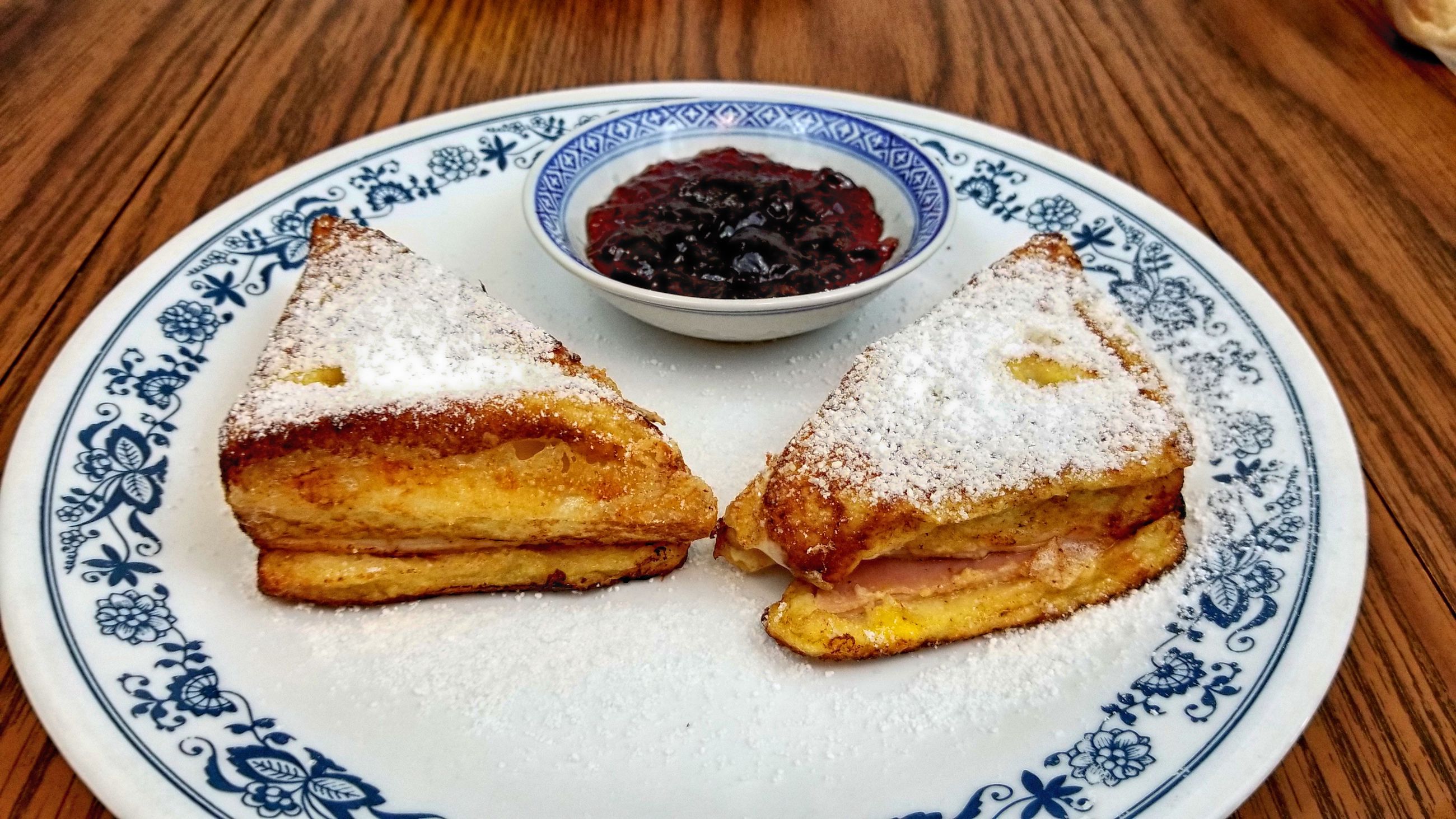

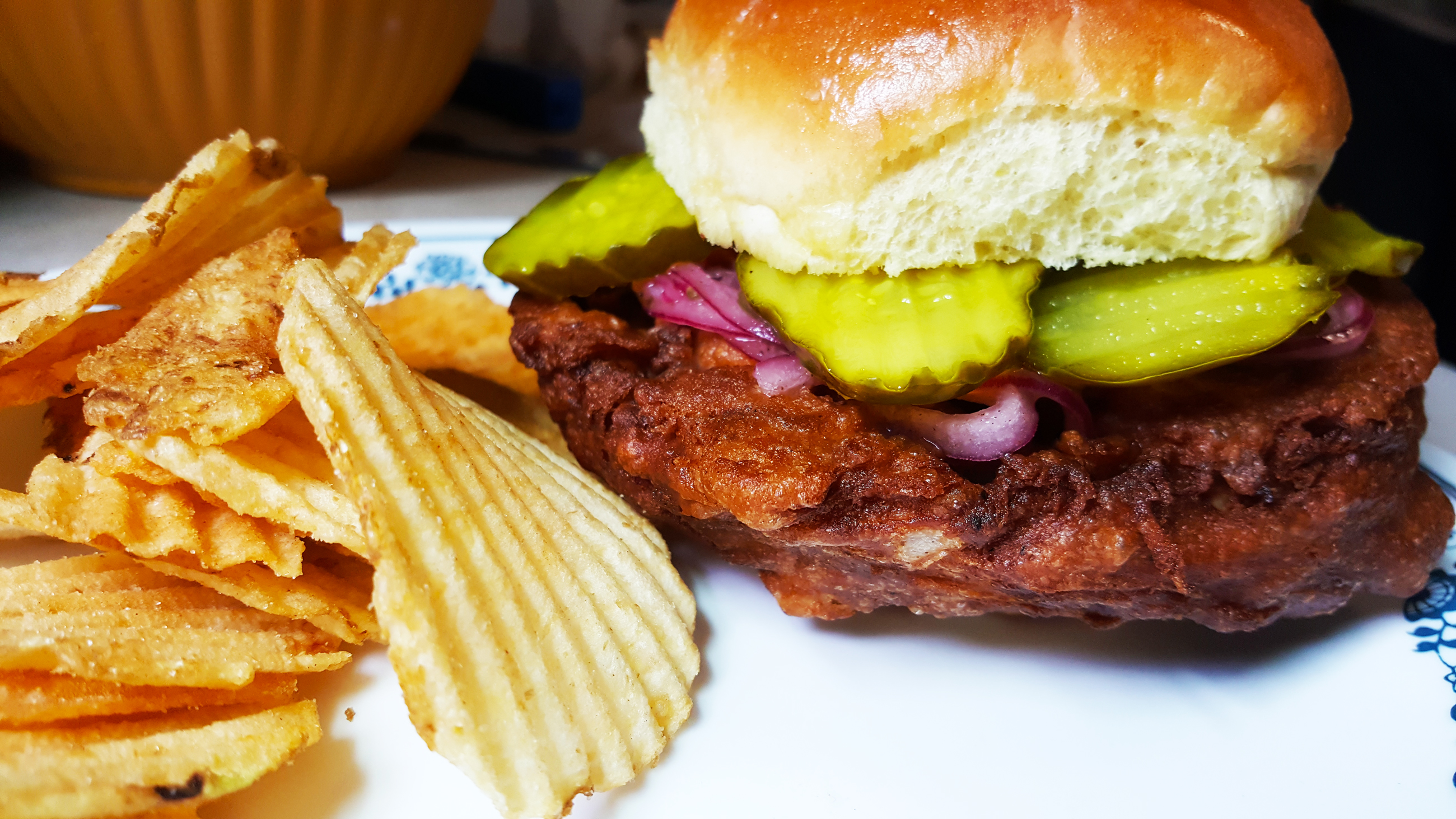






Fantastic post! You might like my post on the same topic as there are recipes you might enjoy there. 🙂 https://www.thefooddictator.com/smorrebrod-danish-open-faced-sandwiches/
Again, great job!